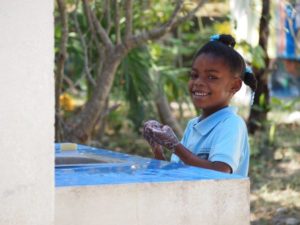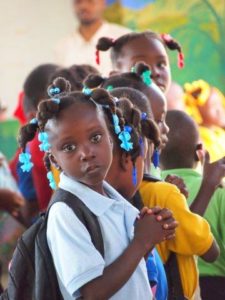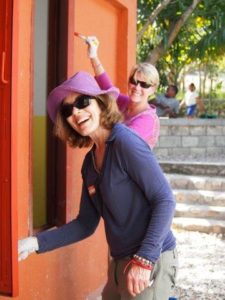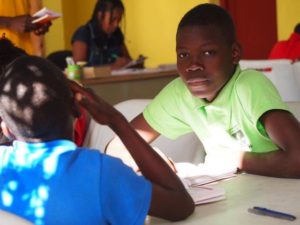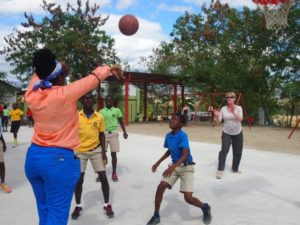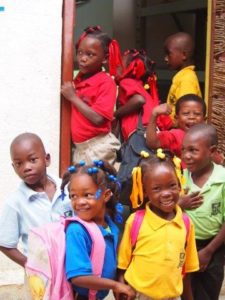Contributed by Antje Gasster, director of EMEA Media & Events for BCD Travel
“Can I borrow your pencil for a minute?” I am just filling in travel papers for Haiti, as I get into a conversation with Jason, my neighbor on this three-hour flight from Atlanta to Port-au-Prince in January.
Jason is on his way to work with a nonprofit group that gives medical help to the people of Haiti. “I’m here to pull teeth. What about you?” asks Jason. I tell him about the nine BCD Travel employees—“ambassadors”—who are visiting L`Ecole de Choix, the School of Choice, in Mirebalais to paint buildings and gather impressions for our colleagues back home.
BCD Travel’s Haiti Project supports L`Ecole de Choix. Last year, employees across the globe raised US$50,000 for the school—a portion of the US$750,000 the BCD Travel Foundation has pledged over five years to help fund operations.
We’re about to land, and Jason kindly leans back so I can see past him and catch a first glimpse out of the window. I see brown mountains, water and a radiant blue sky. Haiti means the “Land of High Mountains.” It’s the poorest country in the Western Hemisphere, haunted by natural catastrophes, government corruption and its colonial legacy.
Progress amid desolation
We land and taxi past a long-forgotten airplane, overgrown with ivy. Somewhere nearby, something is burning—a thick black column of smoke coils several meters high. I meet my fellow BCD employees on the steps. As we alight from the plane, the humid, tropical air takes our breath away.
The arrival hall is thronged with people. The executive director of L´Ecole de Choix is waiting for us. We leave the airport in a convoy of four-wheel-drive Toyotas. I see people selling everything from second-hand boots to Vodou masks and scouring through rubbish alongside famished street dogs. Gleaming chrome motorbikes race over cratered streets.
We don’t notice that we’re leaving Port-au-Prince. The population is just as dense in the surrounding region as in the capital. Arriving at the hotel, my driver asks me, “It’s not so bad, is it?” He means the conditions, and I am speechless at first. But amid the desolation, there’s progress. Music and art enliven the streets I finally agree with him—it’s not so bad.
School is an oasis
It’s 6 a.m., and Haiti is awake. We’re back in our Toyotas, winding through busy streets crowded with tap-taps—brightly painted taxis, some of which even carry passengers on their roofs. After an hour, we reach Mont Kabwit, which means “goat mountain.” Herds wander everywhere. We see few trees; deforestation is a problem, but the country is working on solutions. Thick dust sticks to our windows. We don’t stop during the entire two-hour journey. Our convoy finally arrives at Mirebalais and L`Ecole de Choix.
We pass a guarded school gate, and suddenly an oasis appears before us: palms, banana trees, white and pink bougainvillea. The school staff greets us with smiles. The morning assembly has begun, so we quickly put down our luggage. Around 180 students, ages 6 to 16, are lined up in the school canteen, a large, shady open space. They listen politely to Choix’s school nurse, who is explaining the dangers of diphtheria and the importance of good hygiene.
“Always wash your hands with soap and water,” she explains. The students concentrate—until they notice us. We marvel at each other. They wear shorts and polo shirts in cheerful shades of blue, green, red or yellow. We’re far less colorful and smell suspiciously of mosquito repellant.
Every student gets two polo shirts a year. They choose the colors. The school’s executive director says the Ministry of Education objects to the lack of traditional uniforms. It’s among many things done differently at L´Ecole de Choix, one of the few non-religious schools in Haiti.
Lunch as an incentive
The executive director introduces us: “Welcome to our friends from BCD! Our friends are going to make the school look nicer and last longer.” We wave. Some of the students wave back. The youngest overcome their shyness first. After the assembly, lessons start, and we begin to paint windows, doors and fences. The children come to watch us during breaks. They laugh when we spill paint; their smiles open our hearts.
We’ve done and seen so much that it feels like we’ve already been at the school a full day when lunchtime arrives at 11:30 a.m. There’s chicken with rice and beets, washed down with chilled lemonade. The children eat in shifts—youngest to oldest. The daily warm lunch and morning snack are incentives for parents to send their children to school every day.
The basketball court, sponsored by BCD Travel and Park ‘N Fly, also part of the BCD Group, fills up—despite the heat. A pergola, also sponsored by BCD and Park ‘N Fly, offers shade to children playing with soccer balls and hula-hoops. “Play is important as a counterbalance to all the sitting in the classroom,” the school’s executive director explains. “It’s also an essential component of our educational concept, as it teaches cooperation and teamwork, thus preparing students for leadership.”
Thirsty children help themselves to water from big containers. Parents frequently fill up their home canisters with water when they pick up their children in the afternoon. Some Haitians have to buy drinking water or gather it from potentially contaminated rivers and streams and treat it with purification tablets, if the family can afford them. Cholera has spread rapidly in Haiti since a hurricane hit the island in October 2016. The hurricane also destroyed crops and family vegetable gardens, making more Haitians dependent on contributed food.
A bell rings, and the break is over for the children and for us. As we paint more doors and windows, we hear lessons being taught in classrooms. Children recite texts and sing. We stay quiet and soak everything up.
Ensuring education for boys and girls
The ratio of girls to boys in the school is intentionally 50-50, a balance enabled by allowing families to spread tuition payments over the course of a year. If the money had to be paid all at one time, many families might only send their sons.
The school day finishes at 3 p.m. Some children who live nearby walk home; others board the school bus, which stops throughout Mirebalais. Later, the same school bus takes us back to the hotel. We eat dinner and are exhausted by 7:30 p.m. It feels more like 2 a.m. The days are long in Haiti.
We return the next day to finish our painting work, eat traditional goat stew for lunch and interview a primary school teacher, who explains that he and his colleagues regularly take part in instructional workshops at the school. This focus on continuous teacher training also sets L`Ecole de Choix apart from many other schools in Haiti.
The basketball court is full once more. This time, we ambassadors join in the game. It’s great fun for everyone. We take more photographs—we’ll be leaving soon and want to hold onto our memories.
Saying goodbye
The next morning, we take part in the assembly, then we say goodbye to the children and return over the mountains toward Port-au-Prince. We take a detour to visit the workshops of Papillon Enterprise— where locals make beautiful bracelets from recycled cereal packages. BCD sells these bracelets to raise money for L`Ecole de Choix.
Four days felt like four weeks. We leave Haiti with the certainty that our company is involved in something admirable and important.

Antje Gasster is director of EMEA Media & Events for BCD Travel. She’s based in Bremen, Germany. Watch a video about L`Ecole de Choix and learn more about BCD’s commitment to children who will become Haiti’s future leaders at bcdhaiti.com.
